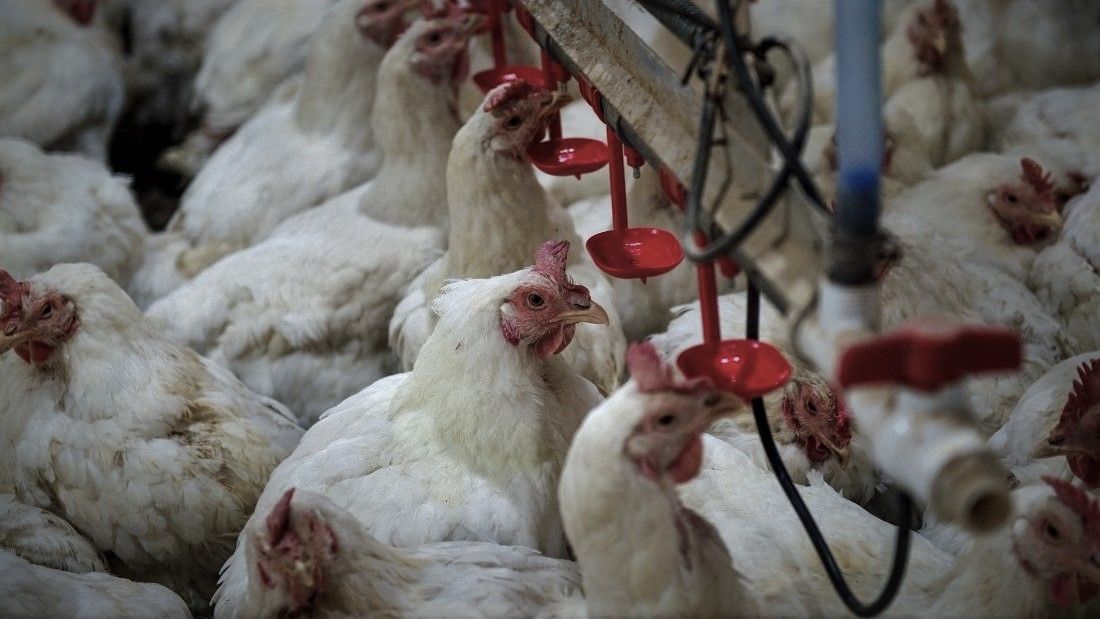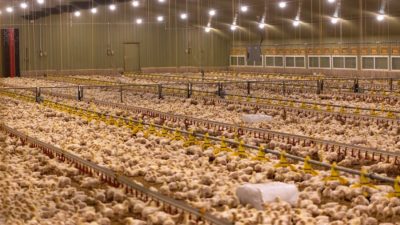Bird flu – the next pandemic?

Covid-19 may be the worst pandemic we’ve seen in 100 years but some scientists fear it may be only a dress-rehearsal for something much worse.
They have been warning us for years about the pandemic threat posed by intensive animal agriculture and wildlife markets. Many thought the next one would be caused by an avian influenza (bird flu) virus, spread to humans from poultry or pigs, rather than a bat coronavirus jumping from pangolins or some other wild animal.
We’ve been here before
Ebola, HIV, SARS and MERS are all examples of zoonotic infectious diseases that spread from animals to humans. These ‘spillover’ events can occur when humans invade wildlife habitats, at wet markets where many different wild and domesticated animals are sold live and slaughtered, or in factory farms, where large numbers of animals are crammed into sheds under horrific conditions. Bird flu is a classic example of a zoonotic disease and the origins of most pandemics can be traced back to avian influenza viruses.
In the wild
Bird flu viruses occur naturally in wild water-birds without making them ill and have done so for millions of years. They are passed on in water from one bird to another. In water-birds, the virus had found an ideal environment in which it could co-exist with its host. But when birds were taken to market, the virus could no longer spread in water and had to mutate or die. In this new, stressful environment, mutations occurred that enabled it to spread via the faeces, nasal, mouth and eye secretions of infected birds.
Spanish flu
The 1918 Spanish flu pandemic was one of the deadliest in human history, with almost one-third of the world’s population (500 million) infected and up to 50 million dead. Most were young, healthy adults aged 15 to 44. Many factors contributed to its lethal impact; soldiers from all over the world came together to endure the horrors of war – stress, fear, cold weather, crowded conditions and poor hygiene – rather like a factory farm – the parallels are stark! The pandemic was caused by an H1N1 avian influenza virus and although it’s not know exactly which animal it came from, it was of avian origin so probably sprang from poultry or wild birds.
Flu viruses are named after the two proteins they carry on their surface; H is for hemagglutinin and N for neuraminidase – these are the little protein spikes on the virus’s surface that help it to invade cells.
Since Spanish flu, there have been three more flu pandemics. These were not caused by completely avian-origin viruses but ‘reassortant viruses’ with avian-origins. In other words, pick-and-mix viruses, combining elements from more than one virus.
Asian flu
The 1957 Asian flu pandemic is estimated to have killed around 1.1 million people. Scientists think that the H2N2 virus that caused it was the product of a wild duck virus combining with one from humans, possibly in pigs, which are seen as mixing vessels, susceptible to infection by viruses from pigs, birds and humans. H2N2 persists in wild and domestic birds and re-emergence in humans could pose a significant threat to those under 50 due to their absence of immunity.
Hong Kong flu
The 1968 Hong Kong flu pandemic resulted in an estimated death rate of one to four million people. The H3N2 virus responsible is thought to have evolved from the virus that caused the previous pandemic combining with an avian influenza virus to produce a novel strain able to infect and spread in humans. The potential role for pigs as the ‘mixing vessel’ may explain how these zoonotic pandemic-causing diseases emerged.
Swine flu
The 2009 swine flu pandemic was caused by an H1N1 virus that began in Mexico and spread rapidly across the world. It contained elements of viruses from humans, birds, North American pigs and Eurasian pigs. The mixing of live pigs through international trade is thought to have created the opportunity for these viruses to mix. Swine flu primarily affected children and younger adults while many older people were immune. The number of deaths during the virus’s first year is estimated at between 150,000 and half a million people. Swine flu is now one of the seasonal flu viruses that circulate each winter. If you had flu in the last few years, there’s a chance it was caused by this virus.
Pig farming has changed dramatically in recent decades and scientists warn that pigs could play an increasingly important role as vectors of pandemic threats. Intensive poultry production also provides a perfect breeding ground for mutating viruses. Chickens are raised in closed, filthy, stressful and crowded industrial facilities with little or no natural light – this is important as UV light harms viruses. We are literally handing viruses the perfect opportunity to mutate into more deadly forms – a perfect storm of our own making.
H5N1 – a cause for concern
The H5N1 virus is a source of particular concern. It has been infecting poultry since the late 1950s but in 1996, a highly pathogenic strain emerged in farmed geese in Guangdong province in China, killing more than 40 per cent of the birds it infected. By 1997, it had spread to poultry farms and live-poultry wet markets in Hong Kong where it infected humans, leading to six deaths. To stop the outbreak, the government ordered the slaughter of more than 1.5 million chickens.
Since 2003, over 800 people have been infected with H5N1 with most cases resulting from handling, slaughtering or eating infected poultry, with just a handful of person-to-person infections among families caring for sick relatives. Over 450 people have died, with fatalities in Indonesia, Egypt, Vietnam, China, Cambodia, Thailand and Canada. The World Health Organisation says the mortality rate for this highly pathogenic virus is about 60 per cent, compared to 0.1 per cent for seasonal flu.
Thankfully, H5N1 tends not to spread easily between people. However, should it mutate and becomes more transmissible, like the common cold for example, it could result in a death rate of anywhere between five and 150 million people, according to David Nabarro, a senior public health expert at the World Health Organisation.
We’ve seen that during a pandemic, people from every city, town and village around the world can risk death simply by shaking someone’s hand, touching their face or simply by inhaling. Surely it’s time we started to consider the fact that our increased consumption of meat isn’t just wreaking havoc on our health and the environment but threatens to spark new pandemics that could kill thousands, maybe millions, of people. It’s time to end factory farming before it ends us.





